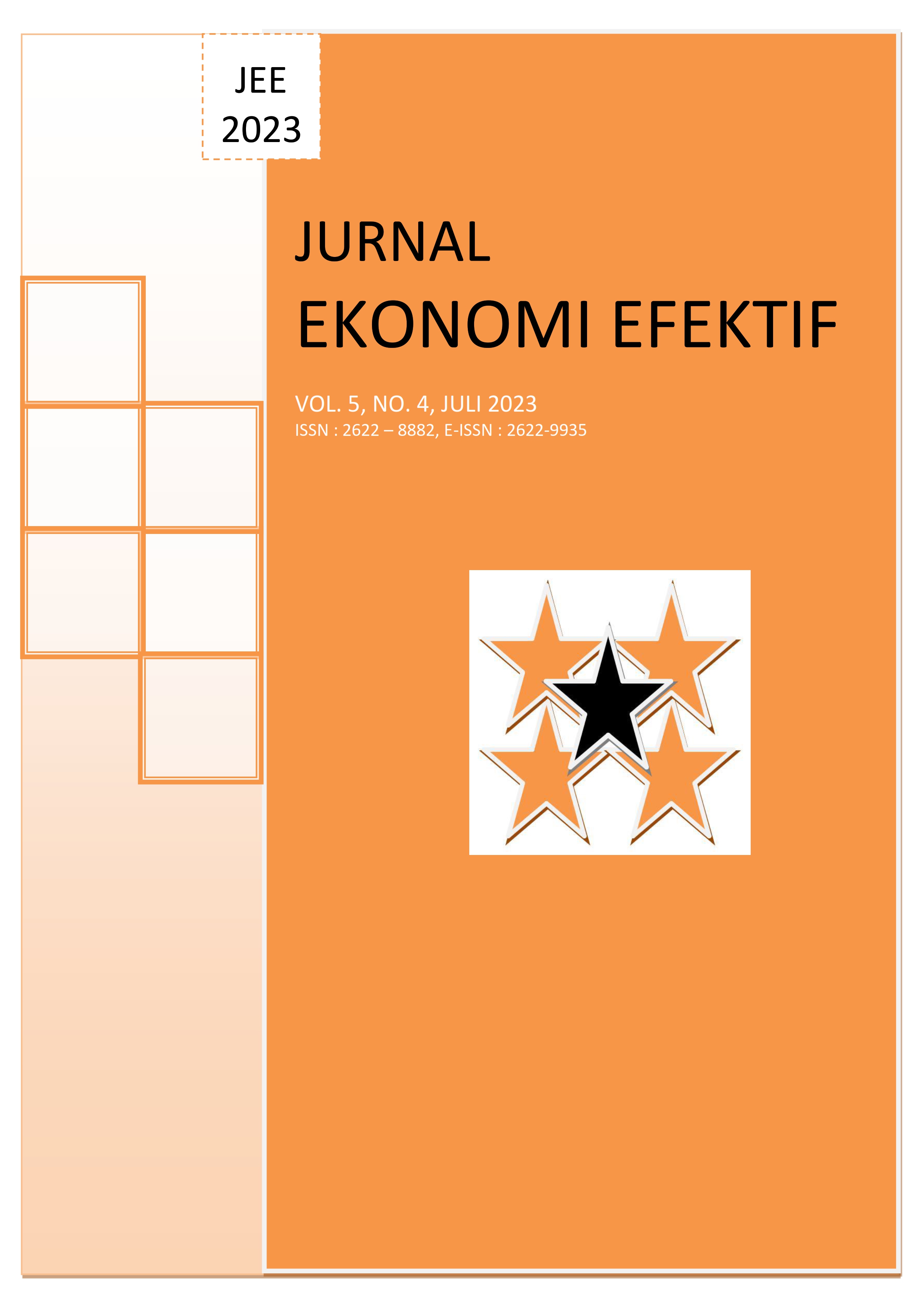Model Penciptaan Nilai Produk Olahan Stroberi di Wilayah Bandung Selatan
DOI:
https://doi.org/10.32493/JEE.v5i4.31428Keywords:
Brand, Branding, DigitalAbstract
Penciptaan Nilai perlu dilakukan oleh pemasar agar produknya memiliki karakteristik khusus yang dapat diidentifikasi oleh konsumen. Salah satu cara untuk menanamkan nilai terhadap produk adalah dengan membuat brand. Selain menjadi media komunikasi dan penghantar pesan, brand mempengaruhi perkembangan ekonomi serta pembentukan nilai sosial yang dianut masyarakat. Dalam budaya populer, brand digunakan untuk memancing respon kognitif serta membangkitkan gairah para calon konsumen. Hasil olahan stroberi yang berlimpah tidak dapat ditawarkan secara maksimal kepada caon pelanggan karena keterbatasan kemampuan dalam menciptakan nilai produk. Dari hasil perhitungan uji parsial pengaruh variabel Branding (X) terhadap variabel Value Creation (Y), diperoleh nilai t-hitung 3,882 dan t-tabel sebesar 1,984 dengan tingkat signifikansi sebesar 0,000, maka dapat dinyatakan bahwa Branding memiliki pengaruh yang signifikan terhadap Value Creation.
References
Bakos, Y. (1998). The Emerging Role of Electronic Marketplaces on the Internet. Communication of The ACM, 41(8), 35–42. www.broadvision.com
Bastos, W., & Levy, S. J. (2012). A history of the concept of branding: Practice and theory. Journal of Historical Research in Marketing, 4(3), 347–368. https://doi.org/10.1108/17557501211252934
Cayla, J., & Arnould, E. J. (2008). A Cultural Approach to Branding in the Global Marketplace. Journal of International Marketing, 16(4), 86–112.
Freudenreich, B., Lüdeke-Freund, F., & Schaltegger, S. (2020). A Stakeholder Theory Perspective on Business Models: Value Creation for Sustainability. Journal of Business Ethics, 166(1), 3–18. https://doi.org/10.1007/s10551-019-04112-z
Giampieri, F., Tulipani, S., Alvarez-Suarez, J. M., Quiles, J. L., Mezzetti, B., & Battino, M. (2012). The strawberry: Composition, nutritional quality, and impact on human health. In Nutrition (Vol. 28, Issue 1, pp. 9–19). https://doi.org/10.1016/j.nut.2011.08.009
Gielens, K., & Steenkamp, J. B. E. M. (2019). Branding in the era of digital (dis)intermediation. International Journal of Research in Marketing, 36(3), 367–384. https://doi.org/10.1016/j.ijresmar.2019.01.005
Hwang, J., Choe, J. Y., Choi, Y. G., & Kim, J. J. (2021). A comparative study on the motivated consumer innovativeness of drone food delivery services before and after the outbreak of COVID-19. Journal of Travel and Tourism Marketing, 38(4), 368–382. https://doi.org/10.1080/10548408.2021.1921671
Kotler, P., & Armstrong, G. (2021). Principles of Marketing. Pearson Education Limited.
Leckie, C., Nyadzayo, M. W., & Johnson, L. W. (2018). Promoting brand engagement behaviors and loyalty through perceived service value and innovativeness. Journal of Services Marketing, 32(1), 70–82. https://doi.org/10.1108/JSM-01-2017-0035
Mahmoud, M. A., Hinson, R. E., & Anim, P. A. (2018). Service innovation and customer satisfaction: the role of customer value creation. European Journal of Innovation Management, 21(3), 402–422. https://doi.org/10.1108/EJIM-09-2017-0117
Mukerji, C., & Schudson, M. (1986). POPULAR CULTURE. Annual Review of Sociology, 12, 47–66.
Murphy, J. (1988). Branding. In Marketing Intelligence & Planning (Vol. 6, Issue 4, pp. 4–8). https://doi.org/10.1108/eb045775
Rooney, J. A. (1995). Branding: A trend for today and tomorrow. Journal of Product & Brand Management, 4(4), 48–55. https://doi.org/10.1108/10610429510097690
Rowley, J. (2004). Online branding. In Online Information Review (Vol. 28, Issue 2, pp. 131–138). https://doi.org/10.1108/14684520410531637
Schroeder, J. E. (2009). The cultural codes of branding. Marketing Theory, 9(1), 123–126. https://doi.org/10.1177/1470593108100067
Smith, J. B., & Colgate, M. (2007). Customer value creation: A practical framework. Journal of Marketing Theory and Practice, 15(1), 7–23. https://doi.org/10.2753/MTP1069-6679150101
Swaminathan, V., Sorescu, A., Steenkamp, J. B. E. M., O’Guinn, T. C. G., & Schmitt, B. (2020). Branding in a Hyperconnected World: Refocusing Theories and Rethinking Boundaries. Journal of Marketing, 84(2), 24–46. https://doi.org/10.1177/0022242919899905
Yen, C. H., Teng, H. Y., & Tzeng, J. C. (2020). Innovativeness and customer value co-creation behaviors: Mediating role of customer engagement. International Journal of Hospitality Management, 88. https://doi.org/10.1016/j.ijhm.2020.102514.
Downloads
Published
How to Cite
Issue
Section
License
Penulis yang menerbitkan jurnal ini menyetujui persyaratan berikut:
Penulis memiliki hak cipta artikel dan menyerahkan kepada jurnal hak publikasi pertama dengan karya yang secara simultan dilisensikan di bawah di bawah persyaratan Atribusi 4.0 Internasional (CC BY 4.0)
 yang memungkinkan orang lain untuk berbagi karya dengan pengakuan kepengarangan karya dan publikasi awal dalam jurnal ini.
yang memungkinkan orang lain untuk berbagi karya dengan pengakuan kepengarangan karya dan publikasi awal dalam jurnal ini.Penulis dapat masuk ke dalam pengaturan kontrak tambahan yang terpisah untuk distribusi non-eksklusif versi jurnal yang diterbitkan dari karya tersebut (misalnya, mempostingnya ke repositori institusional atau menerbitkannya dalam sebuah buku), dengan pengakuan atas karya awalnya publikasi dalam jurnal ini.
Penulis diizinkan dan didorong untuk memposting pekerjaan mereka secara online (misalnya, dalam repositori institusional atau di situs web mereka) sebelum dan selama proses pengajuan, karena dapat menyebabkan pertukaran yang produktif, serta kutipan yang lebih awal dan lebih besar dari karya yang diterbitkan (Lihat The Effect of Open Access).







